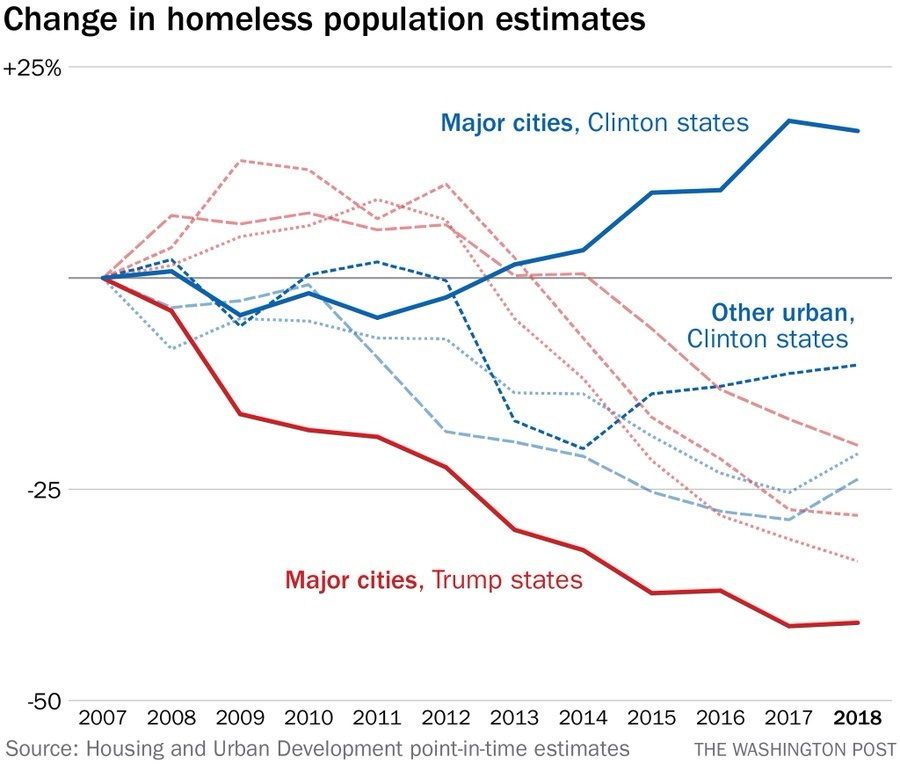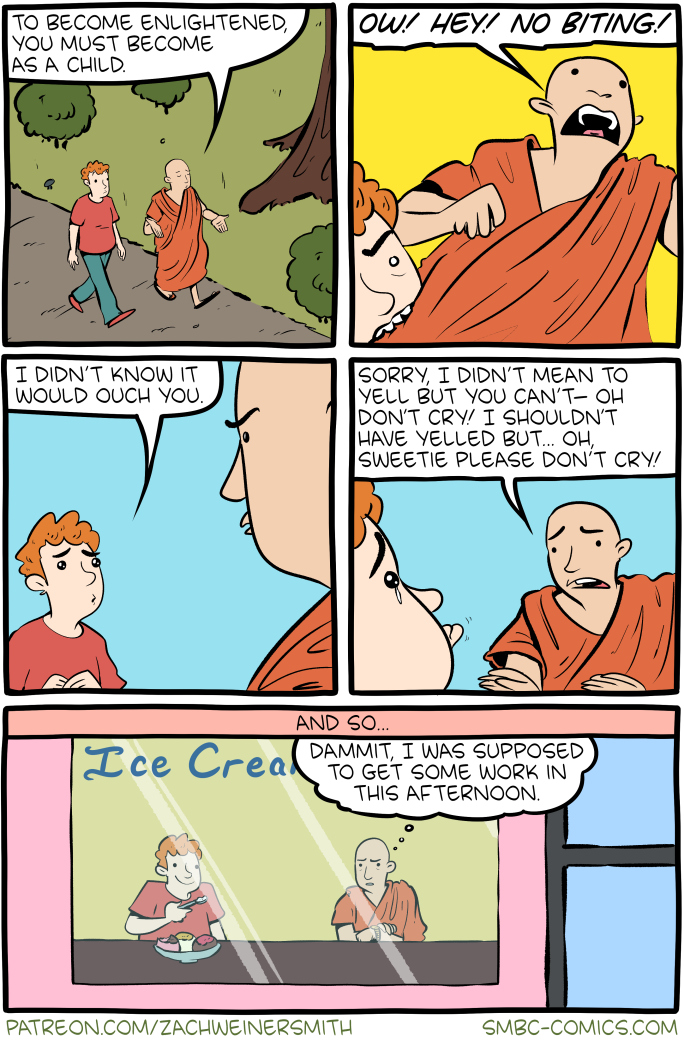
The debate over abundance liberalism unleashed by Ezra Klein and Derek Thompson’s book has, so far, been pretty lopsided. On one hand, you have the abundance liberals themselves, who walk on eggshells to avoid offending the sensibilities of people to their left, in the hope of building a big tent. On the other side, you have a collection of Warrenite progressives and Bernie-faction leftists who simply assume that the abundance liberals are just a bunch of deregulators, and excoriate them for being corporatists and ignoring the dangers of billionaires and oligarchy and such.
Many things frustrate me about this debate. One is that most of the progressive critics of the abundance idea appear not to have actually read Klein and Thompson’s book; they lazily assume it’s all about deregulation, when in fact Klein and Thompson spend more time calling for building up state capacity and the power of the bureaucracy. Another frustrating thing is that the progressive critics seem to assume that their preferred ideas — such as antitrust — are alternatives to abundance, when in fact they usually don’t conflict, and sometimes complement each other.
But what frustrates me most is that by insisting on degrowth over abundance, progressives are hurting themselves much more than they’re hurting any billionaires, oligarchs, or conservatives. Most development policy is set at the city and state level, not at the federal level. Which means by embracing degrowth, progressives are only stifling development in blue states and progressive cities — places like California and Massachusetts. Meanwhile, red states like Texas just keep growing, because progressives can’t tell them what to do.
There are many ways in which this process ends up hurting progressives. Degrowth means blue states lose population, pushing them out with high housing costs. Degrowth means progressive cities become dysfunctional, making life worse for their progressive residents. Degrowth discredits progressive policies at the national level, helping people like Donald Trump win the presidency and Congress.
Back in 2023, I wrote a post called “Blue states don’t build”, about how America’s more conservatively governed states (especially Texas) are better at building housing and green energy than their progressive counterparts (especially California). That post is, if anything, even more relevant today. Even as progressives revile abundance liberals as corporate stooges, degrowth policies are hamstringing progressive politics and progressive communities.
Anyway, here’s my post from 2023. If this isn’t a wake-up call for progressives to abandon degrowth and embrace abundance, I don’t know what would be.
Here’s some bad news for the Democratic Party:

This map shows the number of seats each state is forecast to gain or lose in the House of Representatives by 2030. As you can see, the states losing seats are pretty much all blue states, while the states gaining seats are pretty much all red states.
This is because House seats are reapportioned based on population changes. Blue states are losing seats because they are losing people relative to the U.S. average, while red states are gaining people relative to the average. Here, for example, are the population changes in California and New York (blue states) vs. Texas and Florida (red states) over the past two decades:
Some of this is due to differences in state fertility rates — the Plains states and parts of the South tend to have more kids — but the main driver is simply migration. Americans are moving from blue states to red states:

Why is this happening? It’s obviously not just about the weather, given the moves away from sunny California and into frigid Idaho and Montana. Conservatives will tend to blame the trends on high taxes and progressive social policies in the blue states. But housing costs are far more important, financially, than taxes for most of the people who move from place to place.
Blue states like California and New York have high housing costs in part because these states tend to house “superstar” industry clusters like Silicon Valley, Hollywood, and Wall Street. These clusters draw in high-earning knowledge workers and price out lower-income and middle-income people. But California is losing population at all income levels, with high earners actually more likely to leave. And more importantly, if they wanted, blue states could just build more houses for the lower-income and middle-income people, canceling out the effect of increased demand.
They don’t. With the exception of Washington state (which, you’ll notice, is not forecast to lose any Congressional seats!), blue states tend to be much more restrictive in terms of how much housing they build:

I’m not going to rehash the evidence that allowing more housing supply holds down housing costs. It does. California and New York are driving people out of the state by refusing to build enough housing, while Texas and Florida are welcoming new people with new cheap houses.
In fact, blue states’ failure to allow development is a pervasive feature of their political cultures. Housing scarcity doesn’t just cause population loss — it’s also the primary cause of the wave of homelessness that has swamped California and New York. Progressives’ professed concern for the unhoused is entirely undone by their refusal to allow the creation of new homes near where they live. Nor is housing the only thing that blue states fail to build — anti-development politics is preventing blue states from adopting solar and wind, while red states power ahead. And red states’ willingness to build new factories means that progressive industrial policy is actually benefitting them more.
If blue states are going to thrive in the 21st century, they need to relearn how to build, build, build.
Why red states are winning the green energy race
Texan politicians tend to bash renewable energy in their rhetoric. This is not surprising, given the strength of the oil and gas industry in the state. But if you look at what Texas is actually building, it’s clear that renewables are winning. Solar and wind now power 31% of the entire Texas electrical grid, and if you add nuclear, the proportion rises to 41%:
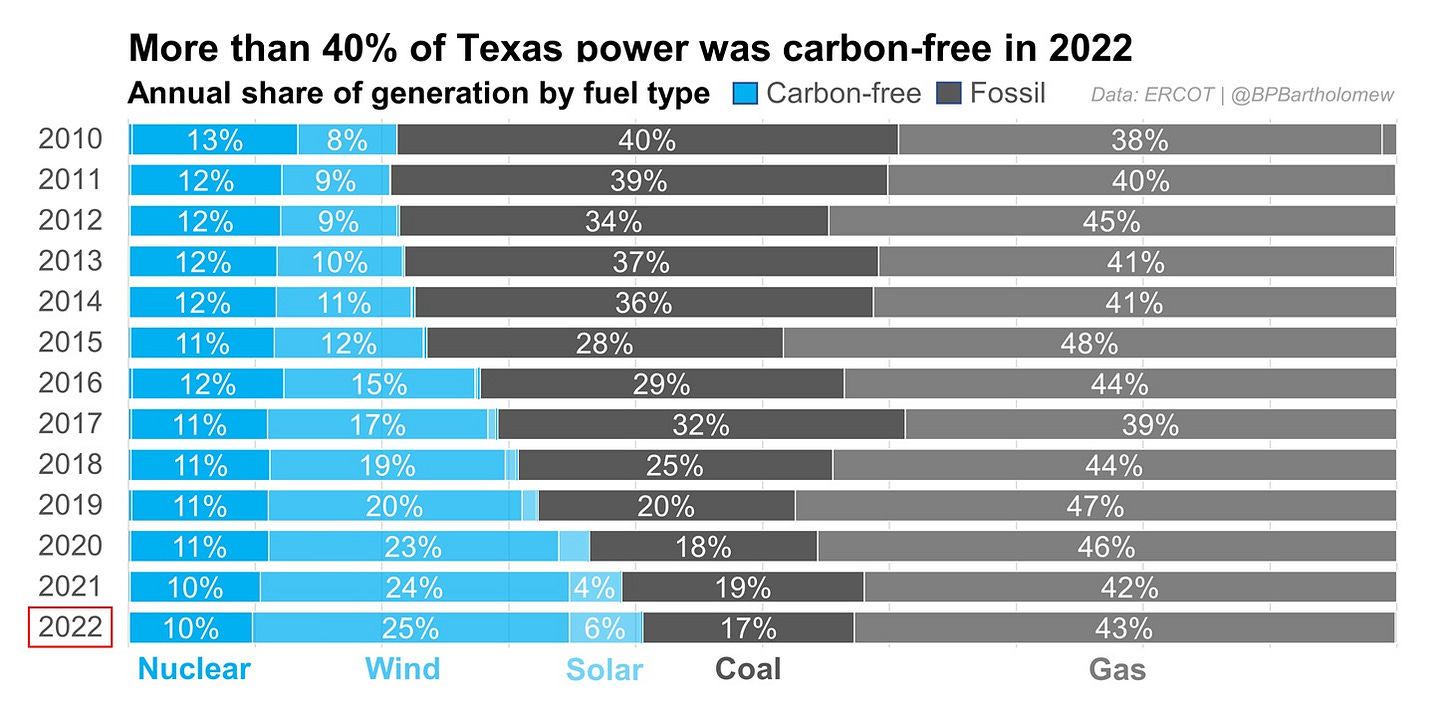
Wind dominates, but Texas has been building out solar incredibly rapidly — far more rapidly than California, for all of the latter’s policies to encourage the industry.

Florida is installing solar very rapidly as well, while New York State and Illinois, despite some plans to catch up, are still lagging severely.
Part of this is because southern states are sunnier. But this doesn’t explain why Texas is outpacing California. Nor does it explain why windy red states like Iowa, Oklahoma, and Kansas have built so much more wind energy than windy blue states like Minnesota, Illinois, and Michigan, despite having less land area and less total electricity demand.
Overall, this means that red states have been beating blue states in the renewables race for years now:
A 2019 top ten ranking of US states’ share of wind and solar power generation as a percentage of overall electricity consumption is dominated by red states…Red states held the top four slots, led by Kansas (53.7%), and followed by Iowa (53.4%), North Dakota (51.1%) and Oklahoma (45.4%).
Why is this happening? Why does Texas, a state dominated by pro-oil politics and conservative culture, have more solar power than sunny California? One answer that observers typically cite is land use permitting:
In Texas, solar permitting is uncomplicated. Connecting projects to the electric grid is straightforward. Then there’s cheap labor, homegrown energy expertise, plenty of sunshine and an anything-goes ethos. “There’s no ‘Mother, may I?’ here,” says Doug Lewin, who worked in the Texas Legislature on energy policy and now advises power companies. “In Texas, it’s just easier to get things done.”
In California, meanwhile, “citizen voice” in the form of anti-development lawsuits is allowing local NIMBYs to block solar projects. This NIMBYism is often facilitated by environmental laws like California’s CEQA, and local NIMBYs often ally with — or even masquerade as — conservation groups. NIMBYism exists in red states too, but strict land-use laws are much more common in blue states, and solar and (especially) wind take up a lot of land.
Another factor is tax policy. Red states tend to have lower taxes in general, but they also give tax incentives for energy projects that will ultimately return more than they cost in terms of tax revenue.
This is why blue states, for all their subsidies and mandates and other policies to promote green energy, are falling behind in the renewables race.
Blue states are swamped with homelessness because they don’t build housing
News stories are filled with apocalyptic tales of homelessness swamping American cities. Oddly, you never seem to hear these stories about Houston or Miami or Dallas or Atlanta. In fact, the homelessness problem in America is almost entirely concentrated in just two states: California and New York.
In my roundup this week I included a chart that showed that the U.S. other than California saw a big drop in homelessness since we started keeping statistics in 2007. But New York is just as bad (and in per capita terms, even worse). Here are the top ten and bottom ten states in terms of the change in homelessness from 2007 to 2023, along with the U.S. total:
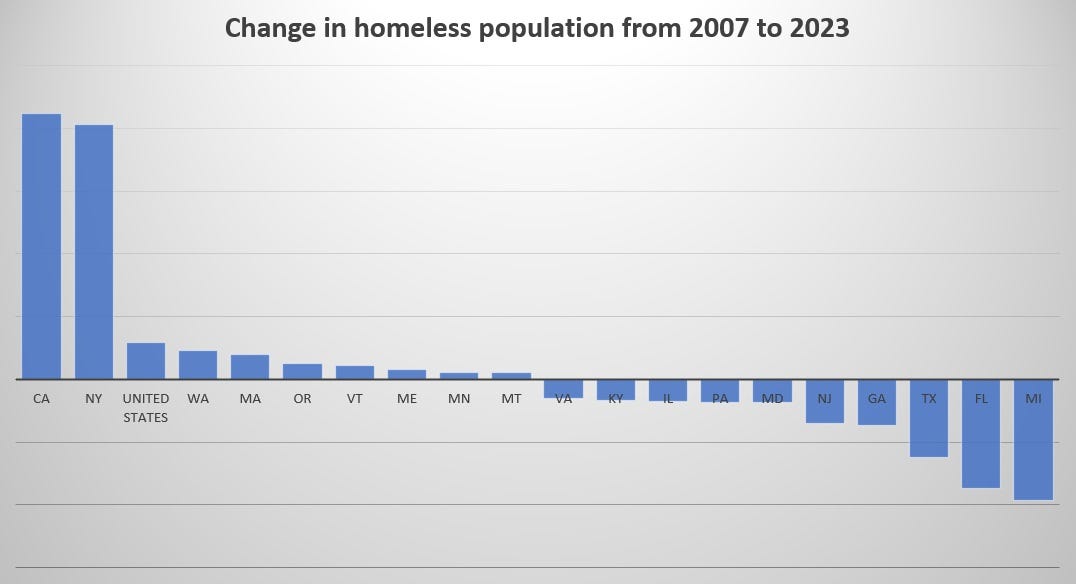
It’s not a perfect correlation, but you can clearly see a divide between the blue states and the red ones. The same pattern holds if you look at cities. Here’s an analysis by Philip Bump from 2020:
Is homelessness caused by high housing costs? Yes. Back in March, Aaron Carr wrote an excellent guest post for Noahpinion that brought together a large amount of data showing that housing costs were a far bigger factor than drug addiction, mental health, weather, or progressive policy when it came to explaining homelessness:
Plenty of other analyses tend to back this up. (Blaming California’s nice weather for an influx of homeless people is my favorite excuse, given that Texas and Florida have reduced homelessness massively, while snowy New York has seen a huge increase!)
The difference is obvious just from looking at cities in California and Texas. Austin has seen rents decline despite a big influx of tech workers, because they went on a home-building spree. Houston has had a massive population boom, but its inflation-adjusted house prices are lower than they were in the 1980s. Unsurprisingly, Los Angeles has 10 times as many homeless people as Houston, despite both cities being sunny and car-centric.
I very strongly recommend Ezra Klein’s recent podcast interview of Jerusalem Demsas. Both writers have been really excellent on covering housing issues, and their discussion strongly backs up what I’m saying.
I’m not going to claim that building housing is entirely without costs. Despite YIMBYs’ love for building taller buildings, urban sprawl is also generally part of the equation — and for red states, urban sprawl explains most of their housing construction advantage. Sprawl is not without its costs, especially in terms of destroying natural habitats — the kind of thing that NEPA and CEQA were intended to prevent. But the pendulum in blue states has simply swung too far toward “build absolutely nothing”, and the result is that they’re losing political clout, economic vitality, and the future of America to the red states.
Industrial policy isn’t helping the states that voted for it
I should also mention one more thing that red states build more of: factories. Many analyses show that Biden’s industrial policies — the IRA for green energy and the CHIPS Act for semiconductors — will send a disproportionate amount of subsidies to red states. This is partly because Biden wants to court voters in those states, and partly because of cheaper labor costs, but mainly because those are the states that are willing to build more solar plants, transmission lines, and factories.
The red-state boom is a good thing. Red states tend to be poorer, so they need the boost more; it’s good to spread jobs out across the country instead of sending them all to traditional superstar clusters like San Francisco or Boston. But the fact that blue states largely resist building factories and energy infrastructure is holding back the nation’s economy as a whole. It makes little economic sense to have almost zero new manufacturing investments on either the West Coast or New England:
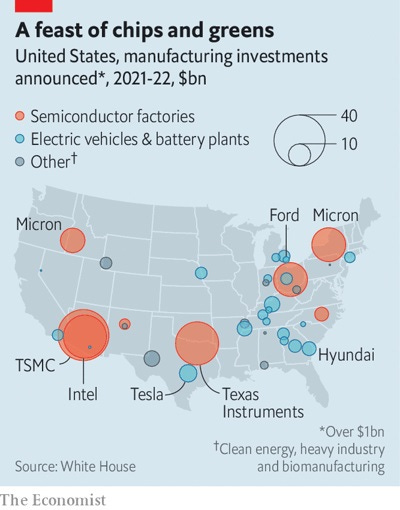
California, New York, and other blue states like Illinois and Massachusetts are, to put it mildly, important parts of the United States. The fact that they’ve been mired in stasis for decades is a big part of the reason the United States has become the Build-Nothing Country.
Yes, it’s important not to destroy natural habitats. Yes, it’s possible for some development projects to disrupt communities. But come on, folks. This has gone way too far. The hordes of people sleeping on the street, the steady drumbeat of people leaving the blue states, and the slowdown of decarbonization are all clear signs that the costs blue states’ love of stasis have become overwhelming. It’s time for them to learn how to build again.

